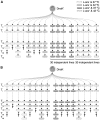The Molecular Chaperone DnaK Is a Source of Mutational Robustness
- PMID: 27497316
- PMCID: PMC5630943
- DOI: 10.1093/gbe/evw176
The Molecular Chaperone DnaK Is a Source of Mutational Robustness
Abstract
Molecular chaperones, also known as heat-shock proteins, refold misfolded proteins and help other proteins reach their native conformation. Thanks to these abilities, some chaperones, such as the Hsp90 protein or the chaperonin GroEL, can buffer the deleterious phenotypic effects of mutations that alter protein structure and function. Hsp70 chaperones use a chaperoning mechanism different from that of Hsp90 and GroEL, and it is not known whether they can also buffer mutations. Here, we show that they can. To this end, we performed a mutation accumulation experiment in Escherichia coli, followed by whole-genome resequencing. Overexpression of the Hsp70 chaperone DnaK helps cells cope with mutational load and completely avoid the extinctions we observe in lineages evolving without chaperone overproduction. Additionally, our sequence data show that DnaK overexpression increases mutational robustness, the tolerance of its clients to nonsynonymous nucleotide substitutions. We also show that this elevated mutational buffering translates into differences in evolutionary rates on intermediate and long evolutionary time scales. Specifically, we studied the evolutionary rates of DnaK clients using the genomes of E. coli, Salmonella enterica, and 83 other gamma-proteobacteria. We find that clients that interact strongly with DnaK evolve faster than weakly interacting clients. Our results imply that all three major chaperone classes can buffer mutations and affect protein evolution. They illustrate how an individual protein like a chaperone can have a disproportionate effect on the evolution of a proteome.
Keywords: DnaK; Escherichia coli; experimental evolution; molecular chaperones; mutational robustness; protein evolution.
© The Author 2016. Published by Oxford University Press on behalf of the Society for Molecular Biology and Evolution.
Figures





Comment in
-
Highlight-Chaperone Proteins Are Evolution's Helping Hand.Genome Biol Evol. 2016 Oct 5;8(9):2992-2993. doi: 10.1093/gbe/evw210. Genome Biol Evol. 2016. PMID: 27707799 Free PMC article. No abstract available.
Similar articles
-
DnaK-Dependent Accelerated Evolutionary Rate in Prokaryotes.Genome Biol Evol. 2016 Jun 3;8(5):1590-9. doi: 10.1093/gbe/evw102. Genome Biol Evol. 2016. PMID: 27189986 Free PMC article.
-
Complementation studies of the DnaK-DnaJ-GrpE chaperone machineries from Vibrio harveyi and Escherichia coli, both in vivo and in vitro.Arch Microbiol. 2004 Dec;182(6):436-49. doi: 10.1007/s00203-004-0727-8. Epub 2004 Sep 24. Arch Microbiol. 2004. PMID: 15448982
-
Interaction of E. coli Hsp90 with DnaK Involves the DnaJ Binding Region of DnaK.J Mol Biol. 2017 Mar 24;429(6):858-872. doi: 10.1016/j.jmb.2016.12.014. Epub 2016 Dec 21. J Mol Biol. 2017. PMID: 28013030 Free PMC article.
-
Toothpicks, serendipity and the emergence of the Escherichia coli DnaK (Hsp70) and GroEL (Hsp60) chaperone machines.Genetics. 2006 Dec;174(4):1699-707. doi: 10.1534/genetics.104.68262. Genetics. 2006. PMID: 17182732 Free PMC article. Review. No abstract available.
-
The Hsp70 chaperone machines of Escherichia coli: a paradigm for the repartition of chaperone functions.Mol Microbiol. 2007 Nov;66(4):840-57. doi: 10.1111/j.1365-2958.2007.05961.x. Epub 2007 Oct 4. Mol Microbiol. 2007. PMID: 17919282 Review.
Cited by
-
The DnaK Chaperone System Buffers the Fitness Cost of Antibiotic Resistance Mutations in Mycobacteria.mBio. 2021 Mar 30;12(2):e00123-21. doi: 10.1128/mBio.00123-21. mBio. 2021. PMID: 33785614 Free PMC article.
-
Highly parallel lab evolution reveals that epistasis can curb the evolution of antibiotic resistance.Nat Commun. 2020 Jun 19;11(1):3105. doi: 10.1038/s41467-020-16932-z. Nat Commun. 2020. PMID: 32561723 Free PMC article.
-
An allosteric inhibitor of bacterial Hsp70 chaperone potentiates antibiotics and mitigates resistance.Cell Chem Biol. 2022 May 19;29(5):854-869.e9. doi: 10.1016/j.chembiol.2021.11.004. Epub 2021 Nov 23. Cell Chem Biol. 2022. PMID: 34818532 Free PMC article.
-
It's not magic - Hsp90 and its effects on genetic and epigenetic variation.Semin Cell Dev Biol. 2019 Apr;88:21-35. doi: 10.1016/j.semcdb.2018.05.015. Epub 2018 Jun 6. Semin Cell Dev Biol. 2019. PMID: 29807130 Free PMC article. Review.
-
Transcriptional Response of Wolbachia to Dengue Virus Infection in Cells of the Mosquito Aedes aegypti.mSphere. 2021 Jun 30;6(3):e0043321. doi: 10.1128/mSphere.00433-21. Online ahead of print. mSphere. 2021. PMID: 34190587 Free PMC article.
References
-
- Bogumil D, Dagan T. 2012. Cumulative impact of chaperone-mediated folding on genome evolution. Biochemistry 51:9941–9953. - PubMed
MeSH terms
Substances
LinkOut - more resources
Full Text Sources
Other Literature Sources
Research Materials

